Ethnic Arteries

A long bus ride to Chicago last weekend gave me plenty of time to catch up on a little reading. While taking the I-90 ride through Cleveland's westside exurbs, past the University of Notre Dame, through gritty Gary and within spitting distance of the White Sox new home (while proudly sporting my Tribe ballcap), I read through much of "Cleveland: A Metropolitan Reader", a collection of essays compiled in the late nineties on the history of social, economic and cultural change. The "Metropolitan Reader," suggests that Cleveland's history of change typifies the struggles and successes in the histories of most American cities - proposing, "Cleveland is a composite of the issues and movements that generally constitute American urban history... Central among these characteristics are privatism, economic restructuring, and ethnicity and race." The book grew from a lecture series at the Maxine Goodman Levin College of Urban Affairs in '90 and '91 in which one set of lectures titled "Changing Urban Practice: Lessons from Cleveland" recounted practices in planning, policy and economic development that changed the City for the better and had instructive value for urban practice in other cities.
After spending some time in a new Polish neighborhood north of Chicago and reading reoccuring commentary on the importance of attracting new populations of immigrants to re-inhabit Cleveland's older urban neighborhoods, Edward Miggins' essay Between Spires and Stacks: The People & Neighborhoods of Cleveland was of particular interest. The essay follows the growth of Cleveland through its waves of ethnic groups and how the villages and neighborhoods created a cultural "mosaic" of development instead of the mythical melting pot that American cities are typically characterized as. While I, as well as most Clevelanders, understand the notion of ethnic "places" such as Little Italy, Slavic Village, Irishtown Bend and Chinatown, some which have retained its character and others since extant, Miggins identifies a more striking pattern of ethnic migration within the city along major arteries. He identifies "Detroit for Irish; Lorain for Germans; St. Clair for Slovenians and Croatians; Mayfield and Euclid for Italians; Kinsman and Woodland for Jews, Italians and Hungarians; Broadway for Poles and Czechs; and West 25th for Ukrainians and Poles." Typical in industrial cities with a history of early suburbanization, these ethnic "conveyor belts", seemingly, are more identifiable as the centers of these nationality groups' history instead of old-world-style village centers.
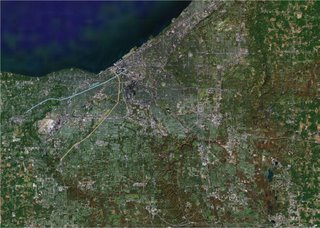
I traveled two of the west-reaching ethnic arteries from Downtown Cleveland to the postwar suburbs. Above is an aerial graphic locating Lorain Road (top) and West 25th Street/Pearl Road (bottom). Below are a few images from each route, tracing the Polish artery from Cleveland to Parma and the German artery from Cleveland to Fairview Park.
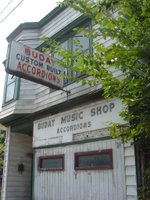

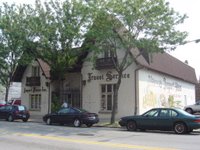
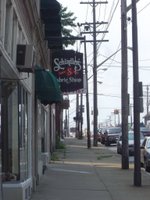
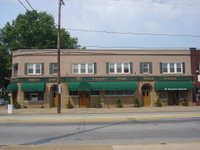
What can be drawn from these local migration patterns? (In my estimation)
Historically, the notion of neighborhood is described with definable edges or centered around shared public spaces. Consider, however, that most American urbanism centers around major public/private corridors and a history of moving in one direction or another along a corridor (yesterday a streetcar route, today an interstate highway) - instead of the melting pot or ethnic mosaic, a city composed of linear strands creating urban 'fabric.' Euclid Avenue, Lorain Avenue, West Sixth Street, Mayfield Road, Coventry Road, I-271, for example, reveal tradition and define the culture and character of this City better than Public Square, Lincoln Park or the Public Mall ever will. Recognizing that the heart of Cleveland commerce and public life is along these 'strands' can focus successful future planning and development in a way that crosses boundaries, connects feifdoms and reverses the direction of migration back into urban neighborhoods. Coordinated efforts to re-focus incentives and reconstruction along these multi-municipality corridors, in much the same way the Euclid Corridor project aims to achieve, will have a strong effect on creating a new healthy City. The tradition of American (especially Cleveland) urban spaces does not concentrate around neighborhood parks and plazas but around its streets and highways.
I highly recommend picking through the "Metropolitan Reader." An easy read, some of the essays include Cleveland: The Making and Remaking of an American City; Politics and the Development of Public Housing; Urban Populism, Fiscal Crisis, and the New Political Economy; Who Governs: The Corporate Hand; Housing: New Lessons, New Models.
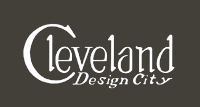
3 Comments:
Great post!
These corridors are essentially (I'll change your words slightly) "multi-municipality" neighborhoods that have sprung from major transit lines that begin in and around Downtown. The Euclid Corridor project realizes this, at least out to University Circle. I'm not so sure who will be traveling from Downtown to UC. After thinking about your post I realized that the Euclid Corridor should be coming from points east rather than from Downtown, although that would be necessary as well. If that were the case, then Mayfield Road from 271 to Euclid would be a great transit corridor in the same vein as the Euclid corridor, although its already quite developed. From the west you have possible corridors such as Lorain, W 25th/Pearl Rd, Detroit, and possibly Clifton/Shoreway.
Redeveloping these "multi-municipality" neighborhoods in a "contextual" manner, say the Lorain corridor with a slightly German "look" (although who is to say what is "German" without it looking kitschy. Maybe that isn’t such a hot idea.). These redevelopments along with a mode of transit similar to the Euclid corridor (or even better the transit system that had once supported these neighborhoods, trolley lines, not just buses that look like trolleys) would at least in my mind be quite successful, much more successful for the redevelopment of Cleveland than say, a lakefront plan or a new development in the Flats.
L.S. Moore
I just read this quote and thought it relevant to our discussion:
"Streets and their sidewalks, the main public places of a city, are its most vital organs. Think of a city and what comes to mind? Its streets. If a city's streets look interesting, the city looks interesting; if they look dull, the city looks dull."
The Death and Life of Great American Cities
Jane Jacobs
L.S. Moore
One thing I'd like to add...
Some of these routes discussed, Detroit in particular, were Native American trails and trade routes - further evidence of the history of these streets as avenues of commerce, public life and migration.
Regions should concentrate resources for better facilitating the movement of people along these corridors and between municipalities and invest in deteriorating stretches that make many of these streets, such as Detroit, discontinuous along its length.
Post a Comment
<< Home